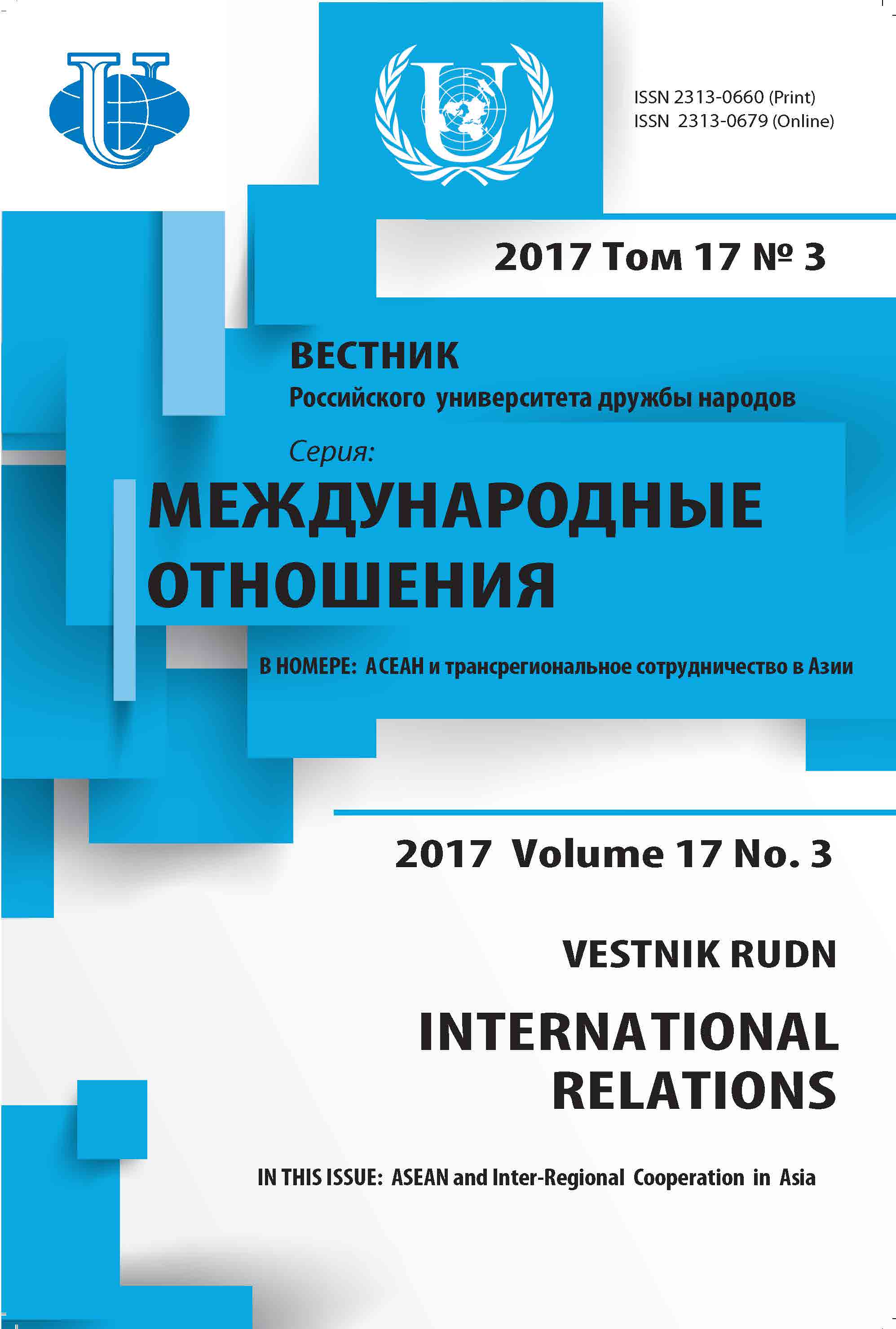THE INTEGRATION MODEL ASEAN+1: THE MAIN NORMS OF AGREEMENTS AND EFFECT ON FOREIGN ECONOMIC TIES
- Authors: Kostyunina GM1
-
Affiliations:
- Moscow State Institute of International Relations (University) of the Ministry of Foreign Affairs of Russian Federation, Moscow, Russia
- Issue: Vol 17, No 3 (2017): ASEAN and Inter-Regional Cooperation in Asia
- Pages: 441-457
- Section: THEMATIC DOSSIER
- URL: https://journals.rudn.ru/international-relations/article/view/16758
- DOI: https://doi.org/10.22363/2313-0660-2017-17-3-441-457
Cite item
Full Text
Abstract
The aim of this research is a comparative analysis of the provisions of free trade agreements signed by ASEAN with dialogue countries and the East Asia Summit partners - China, Japan, the Republic of Korea, India, Australia and New Zealand. The author's thesis is that, in our opinion, the final effect of participation in the free trade zone for the national economy depends on such factors as the volume of mutual trade, the degree of economic interde-pendence, the level of customs duties rates at the date of signing the agreement, the volume of the mutual market, geographical proximity. The higher the role of these factors, the greater the effect of trade creation is received by the participating states. The basis of the research methodology is the understanding of regional integration agreements as a multifactor instrument of trade policy in various countries of the world that facilitates the liberalization of international trade in general and the regional trade in particular, enhancing the participation of partner states in the international division of labor and stimulating the dynamics of their economic development. Such agreements are considered as a system that includes a set of elements that interact with elements of other systems. Such interaction is considered taking into account the specific purpose of each of the elements, and also taking into account the factors of the stability of the development of each system. In carry-ing out this study, the author has used such methods as the method of comparative analysis, which makes it possible to identify the specifics of the participation of ASEAN countries in free trade zones; methods of statistical analysis and political forecasting that provide an opportunity to identify legal norms of integra-tion agreements on the ASEAN + 1 model; as well as a logical conceptual analysis that allows to present a full picture of the ASEAN integration policy. The author analyses norms for regulating the trade in goods and services, investment, distinguishing almost all agreements, as well as intellectual property rights, mobility of individuals and economic cooperation in the framework of some agreements. The article examines the state of trade and investment cooperation between partners in the free trade areas, and comes to the main conclusion about the effect of trade crea-tion, which is expressed in a faster rate of growth in mutual trade and a growth of its share. The greatest economic benefit for ASEAN is the free trade area with China due to such factors as the population size and GDP volume, geographical proximity, the volume of trade at the time of formation of the free trade area, the complementarity of economic structures, and the size of duty rates at the time of signing the agreement. Experience of the functioning of free trade zones within the framework of the ASEAN + 1 shows the importance of wider coverage of economic relations in the liberalization.
Keywords
About the authors
G M Kostyunina
Moscow State Institute of International Relations (University) of the Ministry of Foreign Affairs of Russian Federation, Moscow, Russia
Author for correspondence.
Email: galina_kostynina@yahoo.com
Doctor of Economics, Professor, Professor of Department of International Economic Relations and Foreign Economic Relations of Moscow State Institute of International Relations (University) of the Ministry of Foreign Affairs Russian Federation
References
- Bhagwati, J. (1991). The World Trading System at Risk. Princeton: Princeton University Press.
- Fukunaga, J.& Isono, B. (2013). Taking ASEAN+1 FTAs towards the RCEP: A Mapping Study. ERIA Discussion Paper Series.
- Grossman, G. & Helpman, E. (1995). The politics of free trade agreements. American Economic Review, 85(4), 667—690.
- Hong, Zh. (2015). China and ASEAN: Energy Security, Cooperation and Competition. Singapore: ISEAS.
- Kostyunina, G.M. (2006). The Association of South East Asian Nations (ASEAN). In: Mejdunarod¬naya Ekonomicheskaya Integratciya [The International Economic Integration]. Ed. by N.N. Li¬ventsev. Moscow: Ekonomist, p. 226—260. (in Russ.).
- Kostyunina, G.M. (2015). The ASEAN Economic Community: directions and perspectives of forma¬tion. Rossiiskii vneshneekonomicheskii vestnik [Russian Foreign Economic Review], 12, 14—31.
- Lipsey, R.G. (1970). The Theory of Customs Union: A General Equilibrium Analysis. London: Westfield and Nicolson.
- Meade, J. (1955). The Theory of Customs Unions. Amsterdam: North Holland Co.
- Okabe, M. (2014). The Impact of ASEAN+1 on ASEAN’s Trade. ERIA Research Project Report. Jakarta: ERIA.
- Panagariya, A. (1999). Regionalism in Trade Policy: Essays on Preferential Trading. Singapore: World Scientific.
- Sanchita, Basu Das, Rahul, Sen & Sadhana, Srivastava (2016). Can ASEAN+1 FTAs Be a Pathway towards Negotiating and Designing the Regional Comprehensive Economic Partnership (RCEP) Agreement? Journal of World Trade, 2, 253—288.
- Summers, L. (1991). Regionalism and the world trading system. Policy Implications of Trade and Currency Zones. Federal Reserve Bank of Kansas City, 295—303.
- Urata, Sh. (2010). Japan’s New Trade Policy from GATT and the WTO to FTAs. URL: http://www.waseda-giari.jp/sysimg/imgs/wp2010_e8.pdf (accessed: 13.04.2017).
- Viner, J. (2003). The customs union issue. In: Economic Analysis of Regional Trading Arrangements. Ed. by R. Pomfret. Cheltenham: Edward Elgar.











